Air and Space Museum Paris Le Bourget

Paris Air and Space Museum in Le Bourget Airport exhibits 150 old planes and in total 400 flying machines. Well known for the quality of its collections, it focuses on French airplanes. Paris museums. Museums for kids.
Visit Air and Space Museum
The Paris Air and Space Museum pays tribute to the early 20th century air pioneers with 175 historic airplanes. Based at Le Bourget Airport, the venue of the Paris Air Show.
Le Bourget BP 173 – 93352 France
Locate Paris Air and Space Museum on Paris map.
Paris metro: no metro station near Museum. Take RER B - get off at "Le Bourget" station - then bus line 152.
The museum is open all days except Mondays from 10am to 5pm (6pm from April 1st to September 30th).
Ticket price is 17 euros including the visit of Concorde and Boeing 747, the WW II Dakota airplane experience and a helicopter sea rescue mission.
To see more old planes, visit Paris Technology Museum. For those really interested in historic airplanes, we recommend you to attend the yearly La Ferté Allais historic airplane meeting in June. During the meeting, many historic airplanes take off and land from La Ferté Allais airport.

Ariane V dominated for years the launcher market
Stay in top Paris hotel

Paris Air and Space Museum apartment
Across the street from Paris Air and Space Museum, Appart’City Confort Le Bourget features a restaurant, a 24-hour reception desk and a sauna. The self-catering studios and apartments are provided with WiFi. Each accommodation at Appart’City Confort Le Bourget has a TV, a fully equipped kitchen and a dining area. They also have a private bathroom and toilet. The property has an air-conditioned restaurant, Bistrot City, which is open for lunch and dinner from Monday to Friday. There are 3 meeting rooms, a fitness room and laundry service.
Le Bourget 93150 France

Appartcity apartments near Air and Space Museum
Paris Air and Space Museum apartment
Offering an indoor swimming pool, a fitness center and a restaurant, AC Hotel Paris Le Bourget Airport is located near the Paris Air and Space Museum. With a modern-style décor, all rooms are serviced by a lift and feature air conditioning and a flat-screen TV with satellite and cable channels. The bathroom is complete with a hairdryer and a bath or shower. A fridge is available in each room. The on-site restaurant serves breakfast, lunch and dinner. Children between 0 and 6 years old can enjoy breakfast free of charge.
Le Bourget 93440 France

Marriot Hotel in Le Bourget
Planes at Air and Space Museum
At Paris Air and Space Museum, the core of the collection is exhibited in the 1937 Art Deco Grande Galerie and pays tribute to the early time air pioneer flying machines. It includes the 1879 Massia-Biot glider, the oldest flying machine, the 1907 Voisin-Farman, designed in the Voisin factory in Paris, the first in the world, which accomplished the first one kilometer flight in 1908, the historic Blériot XI airplane, designed by Louis Blériot, the first pilot ever to cross the channel between France and England in 1909.
Many other aircrafts and flying machines make up for a unique collection: legendary aircrafts which fought in World War I and World War II, civilian and military aircrafts from all countries and all times, helicopters and rockets.
The richness of the museum is illustrated by La Demoiselle, the Voisin Farman, the Morane-Saulnier type G, the Douglas and the T6 Texan.
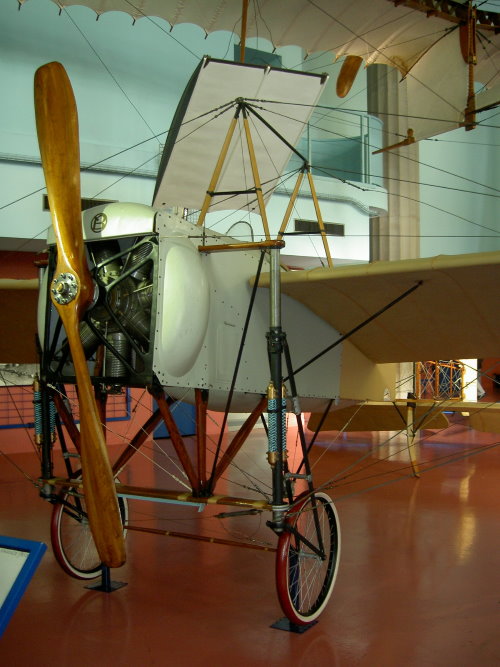
Blériot XI is a historic airplane in Le Bourget
French aviation history through Air and Space museum collections
The visit to the Air and Space Museum begins like a trip to an airport hall. That of Le Bourget in Seine-Saint-Denis, whose historic Art Deco terminal built in 1937 has been restored for five years in a large gallery. A 4,000 m2 space dedicated to the origins of the conquest of the sky. After a quick glance at the glass ceiling of the entrance, the magnificent vaults, the passageways and the period clock, head for the first part of the permanent exhibition, in the north wing, which traces the aeronautics in its infancy. This conquest of man on gravity was done in stages: to rise, to stay in the air and, finally, to learn to steer. An event served as a starting point: the first trip in the air made on November 21, 1783 by Pilâtre de Rozier and the Marquis d'Arlandes aboard the aerostat developed by the Montgolfier brothers. There followed a real passion for hot air balloons in France. Adventurers and scientists competed in imagination to improve balloons and first flying devices. The conquerors of the air, Henri Farman, Félix Tournachon, surnamed Nadar, Louis Blériot, who was the first to cross the English Channel by air, were stared. The visitor can admire the works of art - like the relief portrait of 1783 in gilded bronze of the Montgolfier brothers, posters, paintings which pay homage to them. Also on display are exceptional pieces such as the wicker basket of a postal balloon from 1870, the airship La France, the very first aircraft to perform a closed circuit flight on August 9, 1884, the first gliders, the first wooden planes and in sheet metal, the first seaplane built. This journey into the history of aeronautics shows how the conquest of the air has made it possible to develop meteorology, aerial photography, the transport of mail, goods and men and has completely revolutionized the way of waging war. The 1914-1918 conflict accelerated the rise of aviation. The Germans and allies understood that whoever won the battle in the air would have a better chance of obtaining the final victory. "Aviation should no longer be a service, but a weapon" indicated General Joffre in 1916. This is how the states requisitioned inventors, amateur pilots, companies specializing in aircraft and mobilized part of the effort to war to modernize planes. Some fighter aircrafts surviving from this period, accompanied by newspapers and videos, enrich the testimonies. The inventiveness of the original pioneers and the sacrifice of the intrepid pilots of the Great War helped to advance air transport today. The plane, despite accidents which regularly remind us that technology is never infallible, remains the safest and fastest means of travel possible. Modern aircraft, including the Concorde and the A380, as well as a prototype of the Ariane rocket, which can be visited on the tarmac at Le Bourget, conclude this journey from the sky.
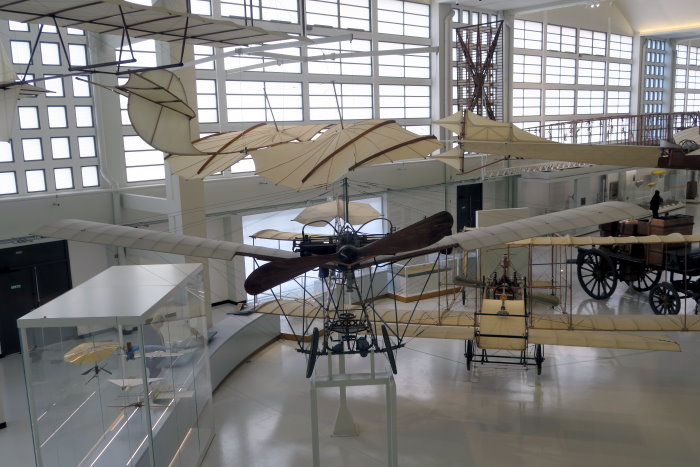
La Demoiselle is the first light aircraft in aeronautics. It was created by the Brazilian engineer Alberto Santos-Dumont. It weighed less than 60 kg, its backbone was made of bamboo and was 8 meters long, the wing was made of fir wood covered with varnished silk canvas. The prototype was his project No. 19 for the one kilometer prize. Alberto Santos-Dumont completed his inaugural flight on November 16, 1907 at Issy-les-Moulineaux, equipped with an engine with two horizontal cylinders Dutheil and Chalmers of 18-20 hp. The airplane was fragile and dangerous because of its landing gear which broke, so that La Demoiselle was nicknamed the "man killer".
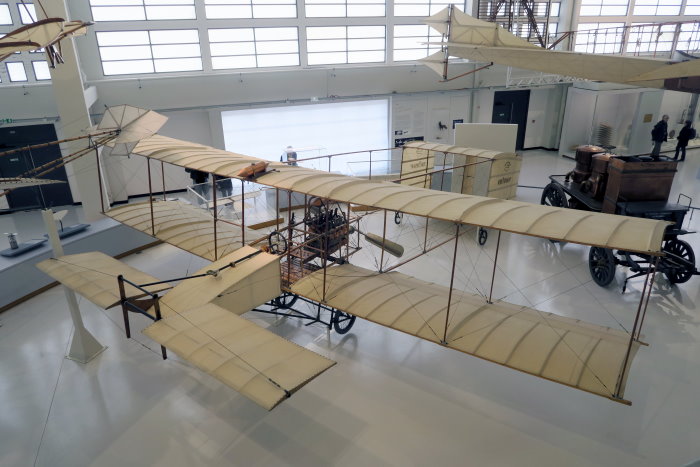
In order to compete for the Deutsch-Archdeacon Cup rewarding the first aviator capable of flying 1,000 m on a closed circuit, Henri Farman ordered from manufacturer Voisin a 50 hp biplane, the Voisin Farman. After three and a half months of testing, he completed the course imposed on January 13, 1908, establishing the manufacturer's world renown. Even if the Wright brothers really invented the pilot of a heavier than air, in practice, France was a crucible for this emerging technique at the beginning of the 20th century. These included the Ferber, Blériot, Fabre but also the Voisin brothers, Gabriel and Charles. If the second will accidentally disappear in 1912, the first will be a major player in the design of airplanes. They were the only ones to build machines that actually flew in 1908, having learned, like the Wright's, to dominate the third dimension when flying "on board" gliders. These would then be the premises of an industry with the creation of multiple airplanes to meet the expectations of wealthy customers, giving their names to the device built by Gabriel Voisin and his team in Billancourt. Among these customers is a certain Henry Farman who will make the first loop circuit (1 km!) in Europe at the controls of his Farman. After a short collaboration with Louis Blériot, which ended with capsizing a common prototype on the Seine, Gabriel Voisin developped and refined his cellular models over time.From the Tourism model, Gabriel Voisin quickly switched to the military model leading to a series of bombers recognizable by their 4-wheel landing gear, the crew (pilot and bomber) being installed in a "bathtub" at the front of the 'device, with good visibility offered by the propulsion engine blowing the tail. It’s a Voisin which would win the first aerial victory with the Frantz-Quenault crew.
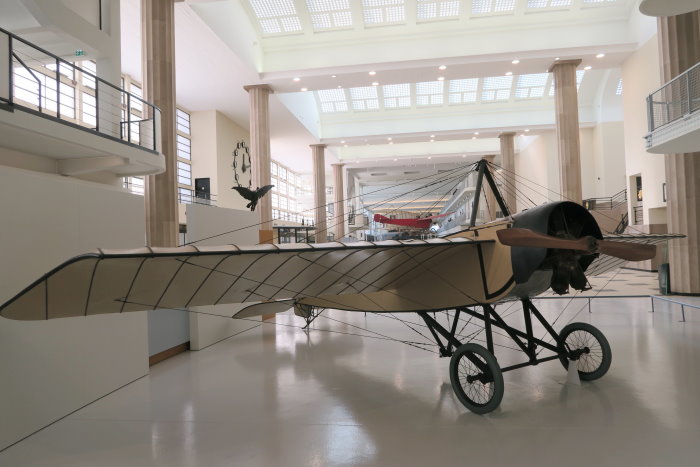
The Morane Saulnier type G is the two-seater version of a device also produced in a single-seater version, the type H. It is part of a family of planes designed by Saulnier and appearing in 1912. Its low mass associated with a powerful engine gave it great popularity among pilots who used it to achieve great performance. In 1913, at the controls of this model of aircraft, Brindejonc des Moulinais made a journey of 5,000 km across Europe, without any incident. On September 23, 1913, the aviator Roland Garros crossed the Mediterranean from Fréjus in France to Bizerte in Tunisia covering 760 km in 8 hours and 7 minutes, a considerable event for the time.
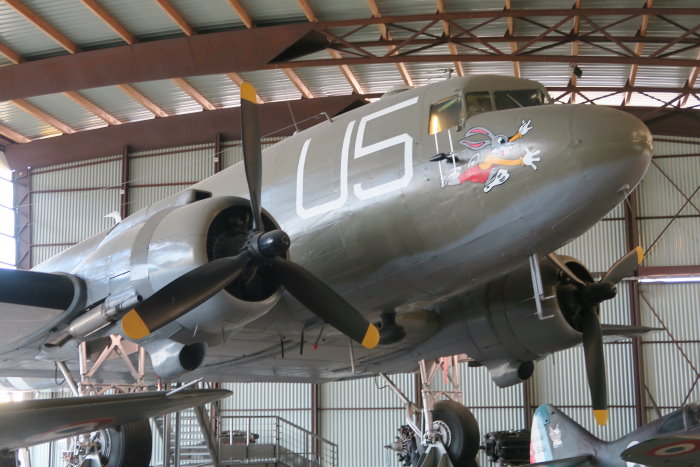
One of the highlights of the museum is a Douglas which can be visited with immersion into D-Day landings flights on Normandy beaches. Developped from the civilian DC-3, the C-47 incuded a a strengthened floor and a double rear door to facilitate the transport of military loads. During World War II, the C-47, renamed the Dakota by the British, was used on all fronts from 1942 and participated massively in the Normandy landings, dropping paratroops and providing supplies to the invasion troops. More than 50,000 paratroops were dropped by C-47s during the first few days of the D-Day. Between March 1943 and August 1945, the Oklahoma City plant produced 5,354 C-47s. More than 10,000 aircraft in total were produced in Long Beach and Santa Monica, California and Oklahoma City, Oklahoma.

The T-6 Texan two-place advanced trainer was the classroom for most of the Allied pilots who flew in World War II. Called the SNJ by the Navy and the Harvard by the British Royal Air Force, the advanced trainer AT-6 was designed as a transition trainer between basic trainers and first-line tactical aircraft. It was redesignated T-6 in 1948. In all, the T-6 trained several hundred thousand pilots in 34 different countries over a period of 25 years. A total of 15,495 of the planes were made. Though most famous as a trainer, the T-6 Texan also won honors in World War II and in the early days of the Korean War.
Air and Space Museum facts.
Paris Air and Space Museum (Musée de l'Air et de l'Espace in French) is located at Le Bourget Airport, 16 km north of Paris on A1 freeway on the way to Charles de Gaulle Paris Airport. Le Bourget Airport opened in 1919. It is the oldest airport in France. The museum was also inaugurated in 1919 at the airport after a proposal by the aeronautics engineer Albert Caquot (1881–1976). This is why Paris Air and Space Museum is also called Le Bourget Museum.
On May 8th 1927, Charles Nungesser and François Coli took off from Le Bourget airport aboard L'Oiseau blanc, a 450-hp Lorraine-powered Levasseur biplane destined for New York, where they planned to ditch in front of the Statue of Liberty. Their plane, which was last seen off the coast of Ireland, never reached New York.
On May 27th 1927, Charles Lindbergh landed in Le Bourget Airport the Spirit of Saint Louis airplane, completing his 33 hour transatlantic flight, the first ever.
History of Le Bourget Airport and Air and Space Museum
From September 1914, the army established an air reserve at Le Bourget, closer to the front than those at Saint-Cyr in the neighbourhood of Versailles. It quickly created an airfield to protect the entrenched camp in Paris from German air attacks. The requisition of agricultural land was immediately followed by the installation of seven wooden and canvas hangars, and barracks for workshops and administrative offices. In 1915, the effectiveness of the squadrons against the night-time attacks by Zeppelins remained disappointing, and the squadrons were sent to the front in rotation by a third. The Le Bourget site was nonetheless experiencing a densification of its infrastructure, mainly in the territory of the commune of Dugny, where the air reserve continued to develop, reaching up to 500 aircrafts.
After First World War, the air reserve continued its activities on the Le Bourget site. In the aftermath of the conflict, civil aviation benefited from installation and equipment at Le Bourget airport which quickly made it the benchmark Parisian airport. The first regular lines served London, Brussels and Amsterdam then, gradually, all of Europe. Le Bourget also became a place to stroll where you came to admire these machines that would soon connect the four corners of the world. It was a place of departure or arrival of large air raids. On May 8, 1927, l'Oiseau Blanc airplane took off from Le Bourget. Its pilots, Charles Nungesser and François Coli, hoped to reach New York nonstop; unfortunately the plane inexplicably disappeared. It was finally Charles Lindbergh who made the first aerial crossing of the North Atlantic between New York and Paris, on May 21, 1927. A huge crowd came to applaud the aviator, winner of the North Atlantic, posing on his Spirit of Saint Louis airplane. A huge crowd also welcomed Edouard Daladier on September 29, 1938, after the signing of the Munich agreements.
In 1935, the architect Georges Labro won the competition for the construction of a new terminal for the international exhibition in Paris in 1937. The winning project was a building with sober architecture, 233 meters long, integrating the set of functions for the reception of passengers and the management of the airport. Not completely completed to welcome the first visitors to the world fair in June, the terminal was officially opened on November 12, 1937. In 1939, Le Bourget Airport, with 21,000 aircraft movements and 138,000 passengers, was the second airport in Europe after that of Berlin-Tempelhof.
During Second World War, the Germans took possession of the airport and enlarged it considerably while occupying the city. On August 16, 1943, American and British forces bombed the runways, but the air base remained occupied until the Liberation. This bombing of August 16, 1943, called operation Starkey, intended to destroy the airport, shaved the town of Dugny to 98% and the north of the city of Le Bourget.
At the Liberation, Le Bourget Airport was rehabilitated by the Americans and the British. From May 1945, 42,000 prisoners of war and deportees were repatriated and then passed through Le Bourget. After the war, airport traffic increased rapidly and, in 1952, Paris acquired a new airport, that of Orly. In the 1960s, the saturation of the latter led to a return of activities at Le Bourget but in 1974, Roissy-en-France airport was opened to traffic. Le Bourget airport was gradually abandoned.
It was at this time that the Air and Space Museum moved to Le Bourget. Founded in 1919 on the proposal of Albert Caquot, the collection began to take shape in a hangar on the Issy-les-Moulineaux site. The museum was inaugurated in 1921, in Chalais-Meudon, then on November 20, 1936, boulevard Victor, in the 15th arrondissement of Paris. During the Second World War and the Occupation, the Germans had it closed: all the exhibits on boulevard Victor were repatriated to Chalais-Meudon after the war. It was from 1973 that the museum gradually moved from Chalais-Meudon to Le Bourget airport, under the impetus of its new director, Air Brigade General Pierre Lissarrague. In 1974, the creation of the new Roissy-Charles-de-Gaulle airport freed up space at Le Bourget and the grouping of collections dispersed in part of the airport hall was studied. The first hall (hall B) was inaugurated in 1975 shortly before the Paris Air Show.
In 2019, the Air and Space Museum celebrated the centenary of its creation. The institution ended the year in style with the end of work in the Grande Galerie, which has been undergoing renovation for five years. The 4,000 m² of exhibition space has been cleared of the walkways that crossed the room. The architects of Atelier Gorka Piqueras have revived the art deco style that already adorns the other parts of the museum. The Grande Galerie brings together the oldest and most precious aircraft of the Bourget Museum, those of the pioneers and the Great War.
